Fowler A. Mathematical Geoscience
Подождите немного. Документ загружается.

270 5 Dunes
It is fairly evident that the scouring conditions which produce lateral bars and
braiding only occur during bank full discharge, when the whole channel is sub-
merged. Such erosive events are associated with major floods, and are by their na-
ture occasional events. In between such floods, vegetation may begin to colonise the
raised bars, and if there is sufficient time, the vegetative root system can stabilise
the sediment against further erosion. A further stabilising effect of vegetation is that
the plants themselves increase the roughness of the bed, thus diminishing the stress
transmitted to the underlying sediment. If the bars become stably colonised by veg-
etation, then the braided channels themselves become stabilised in position, and the
resulting set of channels is known as an anastomosing river system.
The final type of bedform is associated with waveforms in the direction of flow.
Depending on the speed of the flow, these are called dunes or anti-dunes. At high
values of the Froude number (F>1), anti-dunes occur, and at low values (F<1)
dunes occur. A related feature is the ripple, which also occurs at low Froude number.
Ripples are distinguished from dunes by their much smaller scale. Indeed, ripples
and dunes often co-exist, with ripples forming on the larger dunes. The rest of this
chapter focusses on models to describe the formation and evolution of dunes.
5.2 Dunes
Dunes are perhaps best known as the sand dunes of wind-blown deserts. They occur
in a variety of shapes, which reflect differences in prevailing wind directions. Where
wind is largely unidirectional, transverse dunes form. These are ridges which form
at right angles to the prevailing wind. They have a relatively shallow upslope, a
sharp crest, and a steep downslope which is at the limiting angle of friction for slip.
The air flow over the dune separates at the crest, forming a separation bubble behind
the dune. Transverse dunes move at speeds of metres per year in the wind direction.
Linear dunes, or seifs, form parallel to the mean prevailing wind, but are due to
two different prevailing wind directions, which alternatively blow from one or other
side of the dune. Such dunes propagate forward, often in a snakelike manner.
Other types of dunes are the very large star dunes (which resemble starfish),
which form when winds can blow from any direction, and the crescentic barchan
dunes, which occur when there is a limited supply of erodible fine sand. They take
the shape of a crab-like crescent, with the arms pointing in the wind direction.
Barchan dunes have been observed on Mars. (Indeed, it is easier to find images
of dunes on Mars than on Earth.) Figure 5.4 shows images of the four principal
types of dune described above.
As already mentioned, dunes also occur extensively in river flow. At very low
flow rates, ripples form on the bed, and as the flow rate increases, these are replaced
by the longer wavelength and larger amplitude dunes. These are regular scarped fea-
tures, whose steep face points downstream, and which migrate slowly downstream.
They form when the Froude number F<1 (the lower regime), and are associated
with river surface perturbations which are out of phase, and of smaller amplitude.
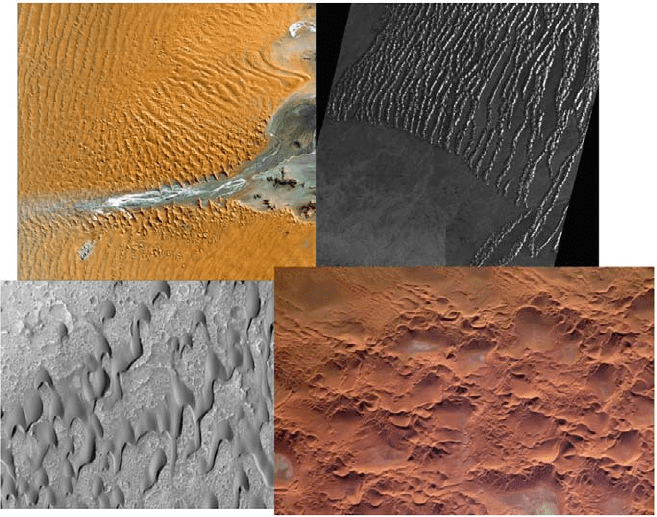
5.2 Dunes 271
Fig. 5.4 Illustrations of four of the most common types of aeolian dunes: transverse (top
left), seif (top right), barchan (bottom left), star (bottom right). The satellite view of transverse
dunes is in the Namibian desert; source: http://earthasart.gsfc.nasa.gov/images/namib_hires.jpg.
The seif dunes are from the Grand Erg Oriental, in the Sahara Desert in Algeria. Im-
age from http://www.eosnap.com/public/media/2009/06/algeria/20090614-algeria-full.jpg,
courtesy of Chelys. The barchanoid dunes are on Mars, so-called dark dunes in
Herschel Crater. Image courtesy of NASA/JPL/University of Arizona, available at
http://hirise.lpl.arizona.edu/PSP_002860_1650. Finally the image of star dunes is an inter-
national space station view of the Issaouane Erg, Algeria. Image courtesy of NASA, available at
http://www.nasaimages.org (image ISS010-E-13539)
The wavelength of dunes is typically comparable to the river depth, the amplitude
is somewhat smaller than the depth.
When the Froude number increases further, the plane bed re-forms at F ≈1, and
then for F>1, we obtain the upper regime, wherein anti-dunes occur. Whereas
dunes are analogous to shock waves, anti-dunes are typically sinusoidal, and are in
phase with the surface perturbations, which can be quite large. They may travel ei-
ther upstream or (more rarely) downstream. Indeed, for the more rapid flows, back-
ward breaking shocks occur at the surface, and chute and pool sequences form.
Anti-dunes can be found on rapid outlet streams on beaches; for example I have
seen them on beach streams in Normandy and Ireland, where the velocity is on the
order of a metre per second, and the flow depth may be several centimetres. A com-
mon observed feature of such flows is their time dependence: anti-dunes form, then
migrate upstream as they steepen, leading to hydraulic jumps and collapse of the
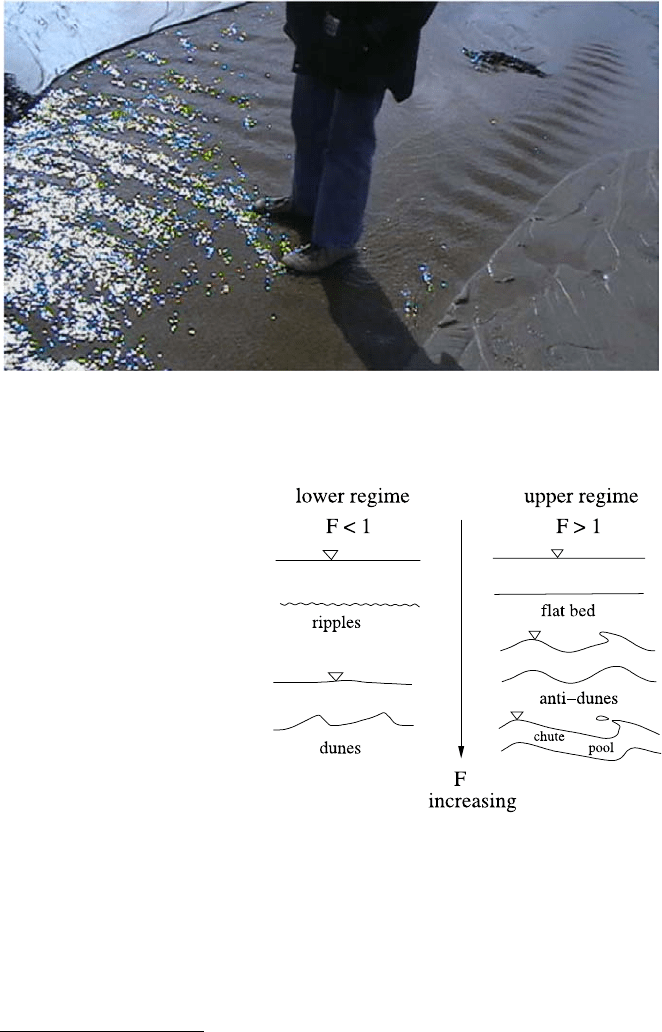
272 5 Dunes
Fig. 5.5 Antidunes on a beach stream at Spanish Point, Co. Clare, Ireland. The waves form, mi-
grate slowly upstream (on a time scale determined by slow sediment transport), break and collapse.
The process then repeats. Image courtesy of Rosie Fowler
Fig. 5.6 The succession of
bedforms which are observed
as the Froude number is
increased. In the lower
regime, where F<1, we see
first ripples and then the
larger dune features. Surface
perturbations are small. In the
upper regime, F>1; dunes
disappear, giving a flat bed,
and then anti-dunes are
formed, in phase with surface
waves. These are often
transient features, occurring
in flood conditions, and they
are likely to be time
dependent also
pattern, only for it to re-form elsewhere. An example of such anti-dunes is shown in
Fig. 5.5. The succession of bedforms as the Froude number increases is illustrated
in Fig. 5.6. Anti-dunes do not form in deserts simply because the Froude number is
never high enough.
1
Dunes and anti-dunes clearly form through the erosion of the underlying bed, and
thus mathematical models to explain them must couple the river flow mechanics
1
The Froude number corresponding to a wind of 20 m s
−1
= 45 miles per hour over a boundary
layer depth of 1 km is 0.2.

5.2 Dunes 273
with those of sediment transport. Sediment transport models are described below.
There are two main classes of bedform models. The most simple and appealing is to
combine the St. Venant equations with an equation for bedform erosion. There are
two ways in which sediment transport occurs, as bedload or as suspended load. Each
transport mechanism gives a different model, and we shall find that a suspended
load transport model can predict the instability which forms anti-dunes, but not
dunes, which indeed may occur in the absence of suspended sediment transport.
2
On the other hand, the St. Venant equations coupled with a simple model of bedload
transport cannot predict instability, although such a model can explain the shape and
speed of dunes.
The other class of model which has been used describes the variation of stream
velocity with depth explicitly. One version employs potential theory, as is custom-
arily done in linearised surface wave theory. At first sight, this appears implausible
insofar as the flow is turbulent, and indeed the model can then only explain dunes
when the bed stress is artificially phase shifted. In order to deal with this properly,
it is necessary to include a more sophisticated description of turbulent flow, and
this can be done using an eddy viscosity model, which is then able to explain dune
formation. The issue of analysing the model beyond the linear instability regime is
more difficult, and some progress in this direction is described in this chapter. In
Appendix B, we discuss the use of an eddy viscosity in simple models of turbulent
shear flows.
5.2.1 Sediment Transport
Transport of grains of a cohesionless bed occurs as bedload or in suspension.Ata
given flow rate, the larger particles will roll along the bed, while the smaller ones
are lifted by turbulent eddies into the flow. Clearly there is a transition between the
two modes of transport: saltating grains essentially bounce along the bed.
Relations to describe sediment transport are ultimately empirical, though the-
ory suggests the use of appropriate dimensionless groups. The basic quantity is the
Shields stress, defined as the dimensionless quantity
τ
∗
=
τ
ρgD
s
. (5.1)
Here τ is the basal shear stress, ρ = ρ
s
−ρ
w
is the excess density of solid grains
over water (ρ
s
is the density of the solid grains, ρ
w
is the density of water), g is
gravity, and D
s
is the grain size. In general, grain sizes are distributed, and the
Shields stress depends on the particle size. The shear stress τ at the bed is usually
related to the mean flow velocity u by the semi-empirical relation (4.9), i.e.,
τ =fρ
w
u
2
, (5.2)
where f is a dimensionless friction factor, of typical value 0.01–0.1. (Larger values
correspond to rougher channels.)
2
This also seems to be true of anti-dunes.
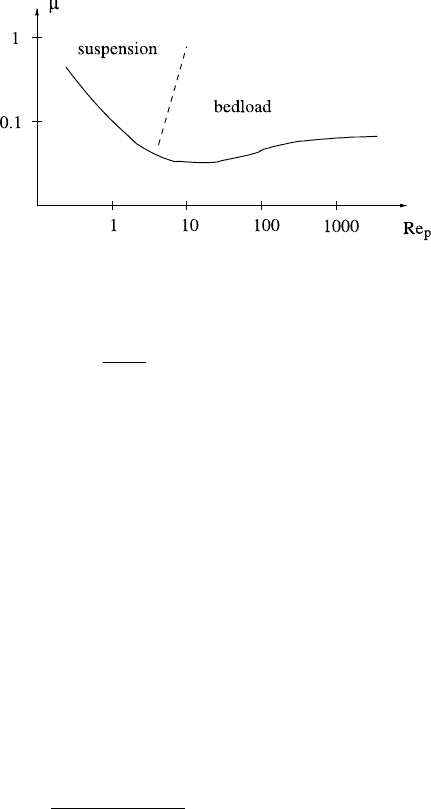
274 5 Dunes
Fig. 5.7 The critical Shields
stress for the onset of
sediment transport, weakly
dependent on the particle
Reynolds number
Re
p
=u
∗
D
s
/ν
Shields found that sediment transport occurred if τ
∗
was greater than a critical
value τ
∗
c
, which itself depends on flow rate via the particle Reynolds number
Re
p
=
u
∗
D
s
ν
. (5.3)
(The friction velocity is defined to be
u
∗
=(τ/ρ
w
)
1/2
.) (5.4)
Figure 5.7 shows the variation of τ
∗
c
with u
∗
D
s
/ν; except at low flow rates,
τ
∗
c
≈0.06.
5.2.2 Bedload
Various recipes have been given for bedload transport, that due to Meyer-Peter and
Müller being popular:
q
∗
=K[τ
∗
−τ
∗
c
]
3/2
+
, (5.5)
where [x]
+
= max(x, 0).HereK = 8, τ
∗
c
= 0.047, and q
∗
is the dimensionless
bedload transport rate, defined by
q
∗
=
q
b
(ρgD
3
s
/ρ
w
)
1/2
, (5.6)
q
b
being the bedload measured as volume per unit stream width per unit time.
5.2.3 Suspended Sediment
Suspended sediment transport is effected through a balance between an erosion flux
v
E
and a deposition flux v
D
, each having units of velocity. The meaning of these is
that ρ
s
v
E
is the mass of sediment eroded from the bed per unit area per unit time,
while ρ
s
v
D
is the mass deposited per unit area per unit time.

5.3 The Potential Model 275
Erosion
It is convenient to define a dimensionless erosion rate E via
v
E
=v
s
E, (5.7)
where v
s
is the particle settling velocity, given by Stokes’s formula
v
s
=
ρgD
2
s
18η
, (5.8)
η being the dynamic viscosity of water. Various expressions for E have been sug-
gested. They share the feature that E is a concave increasing function of basal stress.
Typical is Van Rijn’s relationship
E ∝(τ
∗
−τ
∗
c
)
3/2
Re
1/5
p
; (5.9)
typical measured values of E are in the range 10
−3
–10
−1
.
Deposition
The calculation of deposition flux v
D
is more complicated, as it is analogous to the
calculation of basal shear stress in terms of mean velocity via an eddy viscosity
model, as indicated in Appendix B. We can define the dimensionless deposition flux
D by writing
ρ
s
v
D
=v
s
¯cD, (5.10)
where ¯c is the mean column concentration of suspended sediment, measured as
mass per unit volume of liquid, and D depends on a modified Rouse number R =
v
s
/ε
T
¯u.(Hereε
T
is related to the eddy viscosity; specifically ε
−1
T
is the Reynolds
number based on the eddy viscosity (see (B.9)), so the Rouse number is a Reynolds
number based on particle fall velocity and eddy viscosity.) D increases with R, with
D(0) =1, and a typical form for D is
D =
R
1 −e
−R
(5.11)
(see Appendix B for more details).
5.3 The Potential Model
The first model to explain dune formation dates from 1963, and invoked a potential
flow for the fluid, which was assumed inviscid and irrotational. This is somewhat at
odds with the fact that it is the basal stress of the fluid which drives sediment trans-
port, but one can rationalise this by supposing that the stress is manifested through a
basal turbulent boundary layer. We restrict our attention to two-dimensional motion
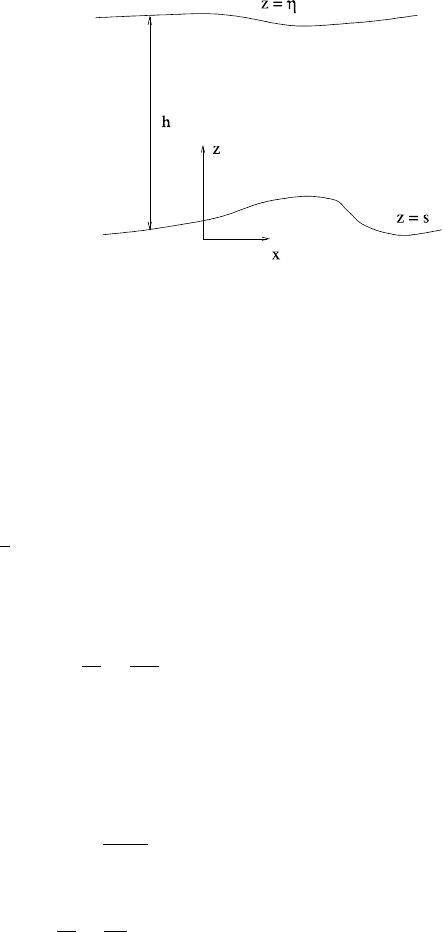
276 5 Dunes
Fig. 5.8 Geometry of the
problem
in the (x, z) plane: x is distance downstream, z is vertically upwards. The bed is at
z =s(x,t), the free water surface is at z =η(x,t), so that the depth h is given by
h =η −s; (5.12)
the geometry is shown in Fig. 5.8. In the potential flow model, the usual equations
for the fluid flow potential φ apply:
∇
2
φ =0ins<z<η,
φ
z
=η
t
+φ
x
η
x
on z =η,
φ
t
+gη +
1
2
|∇φ|
2
=constant on z =η,
φ
z
=s
t
+φ
x
s
x
on z =s.
(5.13)
The extra equation required to describe the evolution of s is the Exner equation:
(1 −n)
∂s
∂t
+
∂q
b
∂x
=0, (5.14)
where n is the porosity of the bed; this assumes bedload transport only, and we may
take (see Eqs. (5.5) and (5.2)) q
b
=q
b
(u), where q
b
(u) > 0. Implicitly, we suppose
a (turbulent) boundary layer at the bed, wherein the basal stress develops through a
shear layer; the basal shear stress will then depend on the outer flow velocity. We
define
q =
q
b
1 −n
, (5.15)
so that
∂s
∂t
+
∂q
∂x
=0. (5.16)
In the absence of any dynamic effect of the bed shape on the flow, we would ex-
pect u, and thus also q, to increase as s increases, due to the constriction of the
flow. If indeed q is an increasing function of the local bed elevation s, then it is
easy to see from (5.16) that perturbations to the uniform state s = 0 will persist as
forward travelling waves, and if q is convex (q
(s) > 0) then the waves will break
5.3 The Potential Model 277
forwards. We interpret slip faces as the consequent shocks, so that this is consistent
with observations. However, such a simple model does not allow for instability.
A simple way in which instability can be induced in the model is by allowing
the maximum stress to occur upstream of the bed elevation maximum, as is indeed
indicated by numerical simulations of the flow. One way to do this is to take
q =q(u|
x−δ
), (5.17)
that is to say, the horizontal velocity u =φ
x
is evaluated at x −δ and z = s, where
the phase lag δ is included to model the notion that in shear flow over a boundary,
such a lag is indeed present. Of course (5.17) is a crude and possibly dangerous way
to model this effect.
To examine the linear stability of a uniform steady state we write s =0, η =h,
φ =Ux +Φ, q =q(U) +Q, η =h +ζ, (5.18)
and then linearise the equations and boundary conditions (which are applied at the
unperturbed boundaries z =0 and z =h) to obtain
∇
2
Φ =0in0<z<h;
Φ
z
=ζ
t
+Uζ
x
,Φ
t
+gζ +UΦ
x
=0onz =h;
Φ
z
=s
t
+Us
x
,s
t
+Q
x
=0onz =0,
(5.19)
where
Q =q
(U)Φ
x
|
x−δ,z=0
. (5.20)
For a mode of wave number k, we put
(ζ,s,Q)=(
¯
ζ,¯s,
¯
Q) ×e
ikx+σt
, (5.21)
and write
Φ =e
ikx+σt
[A cosh kz +B sinhkz], (5.22)
so that the boundary conditions together with (5.20) become
k[A sinh kh +B cosh kh]=(σ +ikU)
¯
ζ,
(σ +ikU)[A cosh kh +B sinh kh]+g
¯
ζ =0,
kB =(σ +ikU)¯s,
σ ¯s +ik
¯
Q =0,
Q =q
ike
−ikδ
A.
(5.23)
Some straightforward algebra leads to
σ
(σ +ikU)
2
+gk tanh kh
+(σ +ikU)kq
e
−ikδ
(σ +ikU)
2
tanhkh +gk
=0, (5.24)
a cubic for σ(k).
Solution of this is facilitated by the observation that we can expect two modes
to correspond to upstream and downstream water wave propagation, while the third
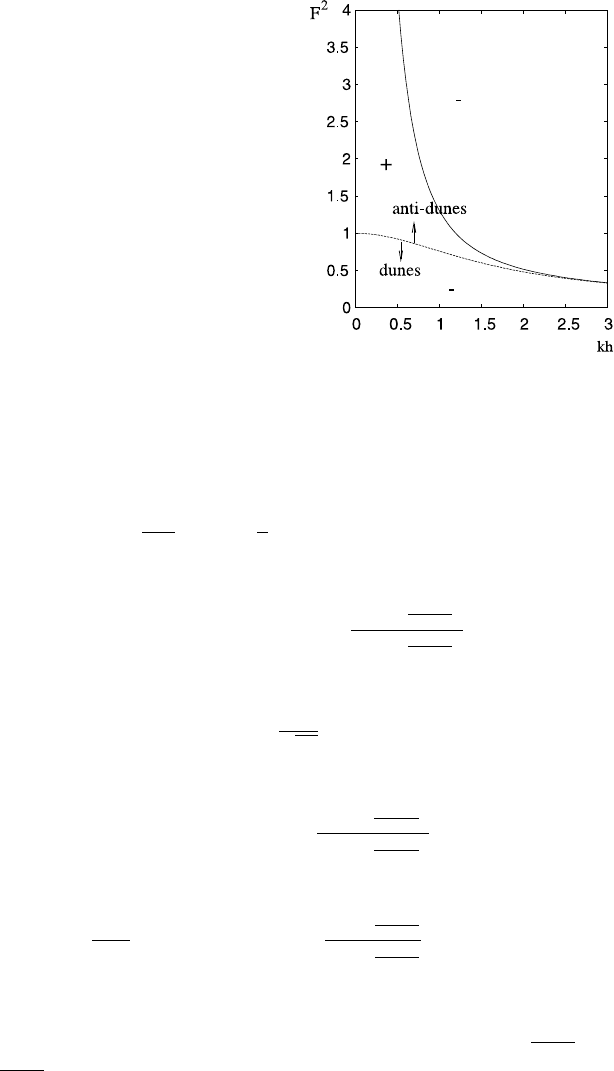
278 5 Dunes
Fig. 5.9 Instability diagram
for the potential flow model.
The regions marked with a
minus sign, above the upper
curve and below the lower
curve, are regions of
instability if δ<0, more
specifically if sin kδ < 0. The
marked distinction between
dunes and anti-dunes is based
on the surface/bed phase
relation (see (5.30)). Wave
motion is downstream if
coskδ > 0, upstream if
coskδ < 0
corresponding to erosion of the bed may be much smaller, basically if q
b
is suffi-
ciently small. Specifically, let us assume (realistically) that q hu. Then we may
assume q
h, and for small q
, the roots of (5.24) are approximately the (stable)
wave modes
σ
−ik
≈U ±
g
k
tanhkh
1/2
, (5.25)
and the erosive mode
σ ≈−k
2
Uq
[sinkδ +i coskδ]tanhkh
F
2
−
cothkh
kh
F
2
−
tanh kh
kh
, (5.26)
where we define the Froude number by
F =
U
√
gh
. (5.27)
For the erosive mode, the growth rate is
Re σ =−k
2
Uq
sinkδ tanh kh
F
2
−
cothkh
kh
F
2
−
tanhkh
kh
, (5.28)
and the wave speed is
−
Im σ
k
=kUq
coskδ tanh kh
F
2
−
cothkh
kh
F
2
−
tanh kh
kh
. (5.29)
This gives us the typical instability diagram shown in Fig. 5.9.Forδ<0(more
specifically, sin kδ < 0) the regions above and below the two curves are unstable,
corresponding to dunes and anti-dunes. The curves are given by F
2
=
cothkh
kh
and
F
2
=
tanh kh
kh
, respectively.

5.4 St. Venant Type Models 279
The phase relation between surface and bed for the erosive bed is given by
¯
ζ
¯s
≈
F
2
sechkh
F
2
−
tanh kh
kh
, (5.30)
and this defines wave forms below the lower curve in Fig. 5.9 as dunes, and those
above as anti-dunes.
Figure 5.9 is promising, at least if sinkδ < 0, as it will predict both dunes and
anti-dunes. To get the wave speed positive, we need in fact to have cos kδ > 0, thus
0 >kδ>−π/2 (we can take −π<kδ<πwithout loss of generality), whereas we
would generally want kδ < −π/2 for anti-dunes to migrate backwards.
There is a serious problem with this model, beyond the fact that the phase shift
δ is arbitrarily included. The spatial delay is unlikely to provide a feasible model
for nonlinear studies; indeed, we see that Re σ ∼k
2
at large k, and in the unstable
regime this is one of the hallmarks of ill-posedness.
Having said that, it will indeed turn out to be the case that a phase lead (δ < 0)
really is the cause of instability. A phase lead means that the stress, and thus the
bedload transport, takes its maximum value on the upstream face of a bump in the
bed. A phase lead will occur because of the effect of the bump on the turbulent
velocity structure above, as we discuss further below. It can also occur through an
effect of bedload inertia (see also Question 5.7).
The choice of wave speed in this theory is unclear, since coskδ can be positive or
negative. The possibly more likely choice of a positive value implies positive wave
speed.
5.4 St. Venant Type Models
Since river flow is typically modelled by the St. Venant equations, it is natural to try
using such a model together with a bed erosion equation to examine the possibility
of instability. This has the added advantage of being more naturally designed for
fully nonlinear studies. A St. Venant/Exner model can be written in the form (cf. the
footnote following (4.46))
s
t
+q
x
=0,
h
t
+(uh)
x
=0,
u
t
+uu
x
=gS −
fu
2
h
−gη
x
,
(5.31)
where S is the downstream slope, q =q(τ), τ =fρ
w
u
2
, and η −s =h. It is conve-
nient to take advantage of the limit q hu, just as we did before, and we do so by
first non-dimensionalising the equations. We choose scales as follows:
s,x,h, η ∼h
0
,u∼u
0
,q∼q
0
,t∼
h
2
0
q
0
, (5.32)
